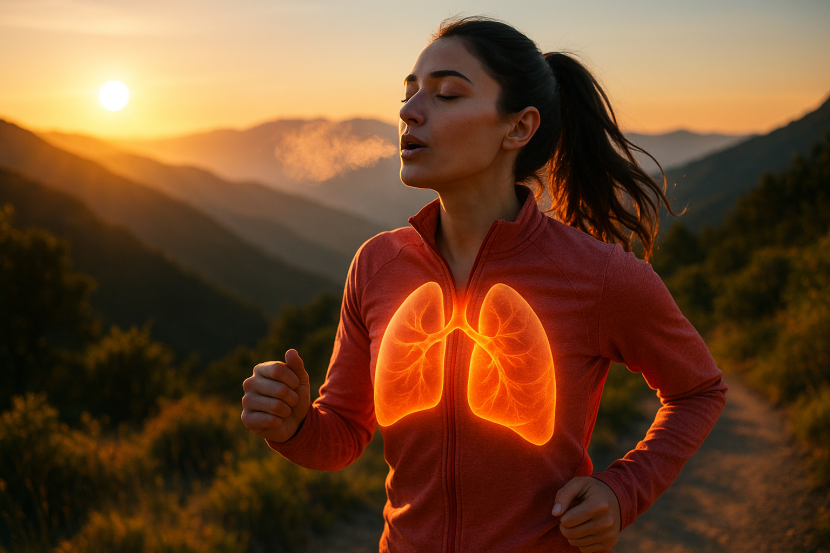Ever feel breathless after just a short climb or a quick walk? If yes, you’re not alone — and the fix might be simpler than you think. While we often focus on training our muscles or boosting heart health, we tend to overlook a powerful engine behind our energy levels: our lungs.
Just like your heart and biceps, your lungs thrive on regular workouts. The good news? Exercise doesn’t just build strength — it also boosts your breathing. From enhancing oxygen flow to increasing lung capacity, physical activity can transform the way you breathe, move, and live.
In this blog, we’ll dive into how giving your lungs a workout can improve endurance, reduce fatigue, and unlock a healthier, more vibrant you.
Understanding Lung Function: Why It Matters

Your lungs aren’t just balloons that inflate and deflate — they’re complex organs that absorb oxygen and expel carbon dioxide, fueling every cell in your body. Healthy lungs mean:
- Better stamina
- Enhanced immune function
- Improved sleep
- Lower risk of respiratory illnesses
However, factors like pollution, smoking, sedentary lifestyle, or asthma can reduce lung efficiency over time. That’s where exercise steps in.
How Exercise Boosts Lung Capacity and Efficiency
According to the American Lung Association, exercise enhances respiratory function in multiple ways:
1. Increased Oxygen Uptake
During physical activity, your body demands more oxygen. To meet this demand:
- Your breathing rate increases
- Lung alveoli (air sacs) become more active
- Oxygen exchange becomes more efficient
This means your lungs become better at pulling in oxygen and pushing out carbon dioxide, even when you’re at rest.
2. Strengthening of Respiratory Muscles
The diaphragm and intercostal muscles (between the ribs) play a vital role in breathing. Exercise, especially cardio and resistance training, strengthens these muscles, making each breath deeper and more efficient.
3. Improved Lung Elasticity
Regular aerobic exercise keeps your lungs flexible and elastic, helping them expand and contract fully. This is especially crucial for people with asthma or mild COPD.
Best Types of Exercises for Lung Health
Not all exercises impact the lungs the same way. Here are the most lung-beneficial types of movement:
1. Aerobic Exercises (Cardio)

- Examples: Walking, running, swimming, cycling, dancing
- How they help: Boost endurance, improve lung circulation, increase oxygen demand
- Frequency: 30 minutes/day, 5 times a week
- Bonus: Great for heart health too!
2. Strength Training
- Examples: Weightlifting, resistance bands, bodyweight exercises (push-ups, squats)
- How they help: Strengthens respiratory muscles indirectly, improves overall physical strength
- Frequency: 2-3 times/week
3. Breathing Exercises
i) Pursed-Lip Breathing
Purpose: Slow down breathing, relieve shortness of breath, improve airflow
How It Works:
Pursed-lip breathing involves inhaling through the nose and exhaling slowly through pursed lips (like blowing out a candle). This slows your breathing rate and keeps your airways open longer during exhalation.
Steps:
- Inhale slowly through your nose for about 2 seconds.
- Purse your lips — as if you’re about to whistle.
- Exhale gently through pursed lips for 4–6 seconds, or twice as long as your inhale.
- Repeat for several minutes.
Benefits:
- Reduces breathlessness, especially during physical activity
- Prevents air trapping in lungs (especially helpful for COPD or asthma)
- Improves ventilation and oxygen exchange
- Promotes relaxation during anxiety or exertion
When to Use:
- During moderate physical exertion (e.g., climbing stairs, walking uphill)
- To calm down in high-stress or breathless moment
ii) Diaphragmatic Breathing (Abdominal/Belly Breathing)

Purpose: Strengthen the diaphragm, increase lung efficiency
How It Works:
This technique engages the diaphragm, the primary muscle used in breathing. Instead of shallow chest breathing, you breathe deeply into your abdomen, allowing the diaphragm to do most of the work.
Steps:
- Sit or lie comfortably, place one hand on your chest and the other on your belly.
- Inhale deeply through your nose, allowing your belly to rise (your chest should move very little).
- Exhale slowly through your mouth, tightening your abdominal muscles and letting the belly fall.
- Repeat for 5–10 minutes daily.
Benefits:
- Improves oxygen exchange
- Strengthens the diaphragm
- Reduces breathing effort and fatigue
- Promotes relaxation and reduces anxiety
- Helps manage chronic respiratory conditions like COPD and bronchitis
When to Use:
- As a daily practice to train efficient breathing
- During yoga or meditation sessions
- To improve athletic endurance and lung control
iii) Box Breathing (Four-Square Breathing)
Purpose: Improve focus, regulate breathing, reduce stress
How It Works:
Box breathing is a structured breathing technique used by athletes, performers, and even Navy SEALs to improve mental clarity and control under pressure. It involves breathing in equal counts — like drawing a square.
Steps:
- Inhale through your nose for a count of 4.
- Hold your breath for a count of 4.
- Exhale through your mouth for a count of 4.
- Hold again for 4 counts.
- Repeat the full cycle 4–5 times.
Benefits:
- Enhances lung capacity and breath control
- Reduces anxiety, panic, and emotional reactivity
- Lowers blood pressure and heart rate
- Sharpens focus, concentration, and mindfulness
- Useful in high-pressure situations (public speaking, sports, emergencies)
When to Use:
- During high-stress moments
- As a warm-up or cool-down for physical exercise
- Before sleep or to reset your mind during work
4. Yoga and Tai Chi

Mind-body practices like yoga and Tai Chi combine breath control with movement, offering physical and mental benefits:
- Increase lung capacity
- Reduce stress (which affects breathing)
- Improve posture and alignment, aiding deeper breaths
Exercise for People with Asthma or Lung Conditions
Many people with asthma or chronic bronchitis fear exercise due to potential breathlessness. But when done correctly and under supervision, exercise can actually:
- Reduce asthma attacks
- Improve FEV1 (Forced Expiratory Volume)
- Increase tolerance to triggers (dust, cold air, allergens)
Tips for Exercising with Lung Issues:
- Warm up for at least 10 minutes
- Avoid cold or polluted environments
- Carry an inhaler if needed
- Choose low-impact workouts like swimming or elliptical machines
Lifestyle Tips to Complement Your Breathing Workouts
To get the most out of your breathing and fitness routine:
- Avoid Smoking: Even secondhand smoke damages lung tissue.
- Eat Antioxidant-Rich Foods: Berries, citrus fruits, and leafy greens support lung repair.
- Stay Hydrated: Thins mucus and keeps airways clear.
- Check Air Quality Index (AQI): Avoid outdoor workouts on high-pollution days.
- Practice Good Posture: A straight spine allows for full lung expansion.
The Mind-Lung Connection
Stress, anxiety, and poor sleep can negatively affect breathing patterns. Exercise triggers the release of endorphins, the feel-good hormones, which:
- Reduce stress
- Enhance mood
- Promote deeper, slower breathing even at rest
Final Thoughts: Breathe Better, Live Longer
Your lungs are not passive organs—they respond, adapt, and grow stronger with consistent training. Whether you’re an athlete or a beginner, building lung power through movement isn’t just about better workouts — it’s about better living.
Takeaway:
- Start small, be consistent
- Mix aerobic, strength, and breathing workouts
- Support with lifestyle and nutrition
- Don’t ignore your breath — it’s your lifeline!




